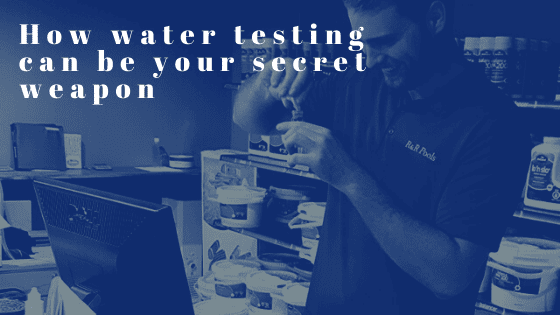How water testing can be your secret weapon!

Testing of your pool water is vital to ensure your pool is always at its best to keep your loved ones safe while swimming. Many times, a pool can look crystal clear to your eyes, but does require some attention. By taking an accurate reading of the water conditions, you can save time and money by preventing over treatment, or under treatment that changes the clarity from crystal clear to green and cloudy.
Water testing can be completed at home using a test strip or a drop kit system. Both systems are good for testing your sanitizer and pH levels in the pool to ensure they are safe for swimming. You want to see the free chlorine range be between 1 – 3 ppm in a chlorine sanitized pool. If you are using a bromine sanitizer, the ideal range is between 2 – 4 ppm. Your pH levels should be between 7.4 – 7.6. Home testing should take place at a minimum of once per week.
You should also bring your water in to your local pool professional once per month so they can test other areas of the water – such as your alkalinity, calcium, CYA, and Total Dissolved Solid (TDS) levels. Using the chemicals from your local pool professional provides you with the most accurate readings on your water, and the correct dosages being added to your pool.
Here are some helpful hints on water testing:
For all water testing:
- Do not shock the pool prior to testing the water.
- Take the water sample from elbow deep in the water, not from the top surface.
- Once you have added the required product (basing the amounts needed by using the guide on your chemical container for at home testing) allow the water to circulate for 24 hours and retest to ensure the ideal range has been met.
At home:
- Be careful if using a drop kit, one drop to many can provide you with a false reading.
- Do not wait to long to read the results, follow the label on the test strips for actual wait times (typically about a 10-20 second wait)
- Do not play with chemicals trying to figure out amounts without the assistance of a testing kit, you may end up with chemical soup in your pool.
- Store your testing kit in a cool, dark area and prevent strips from becoming damp or wet.
- Testing kits do expire. Test strips typically will have an expiration date printed on the bottle, while reagents for drop testing should be replaced each season.
At the pool professionals:
- Take in a list of chemicals you already have at home to avoid purchasing the same chemical. A lot of professionals will not return chemicals for liability reasons.
- Mark down the water temperature in the pool when you take the sample.
- Do not bring your water in an old chemical, juice or pickle container. Glass and plastic have a memory, no matter how well you rinse the container and these products may affect the outcome of the test, providing you with inaccurate readings and possibly overdosing or under dosing the water. A rinsed-out water or soda bottle are fine to use.
- Make a list of any questions you may have regarding the pool, so you do not forget the information while you are there. If you are experiencing any issues with the water and clarity, be sure to let the professional know.
- Be sure to know the liter amounts of your pool if this is your first visit to the professional for water testing.
- Do not visit more than one pool professional for advice when you are trying to rectify an issue in the water. Pool professionals may carry different brands of chemicals and you may end up with too much product in the pool that could potentially cause issues and / or damage. If you are unhappy with the service you have received, and want to try a new professional, make sure you advise them on what was added to the pool, and when, so they can help you make a good decision regarding your next step.
